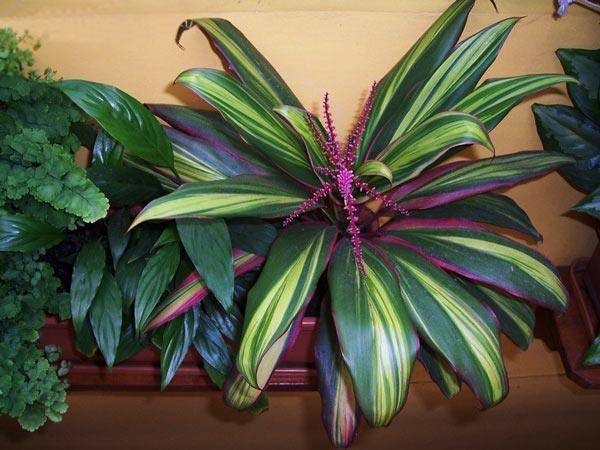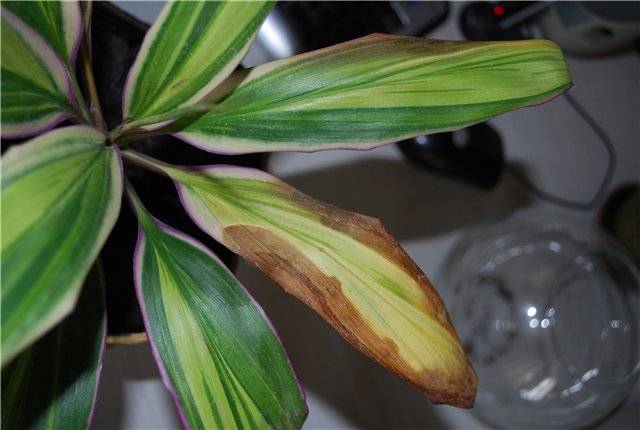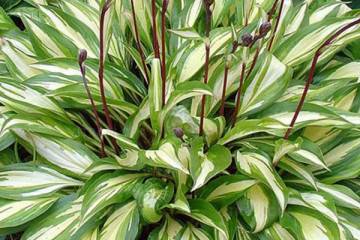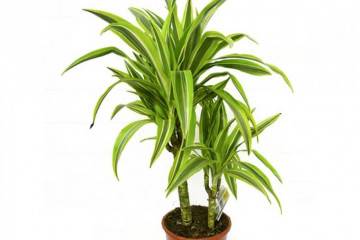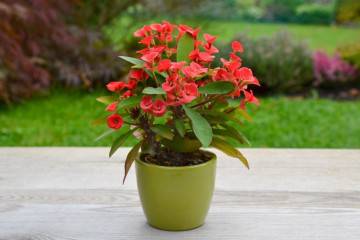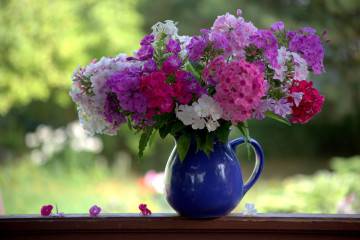Cordilina flower - types, varieties, how to care
Content:
Cordilina is a vibrant and impressive plant. In the room, it stands out from other colors not only for its color. Its leaves deserve special attention: wide, shiny, as if soft. It is very similar to a palm tree and is often confused with dracaena. But this is a separate plant with which flower growers love to decorate their homes.
What does Cordilina look like, which family does it belong to
The unusual plant has about 20 species that differ from each other both in size and in the shape of the leaves, their color. A feature of this exotic is the falling off of old leaves. So the trunk is exposed, and the flower begins to look like a palm tree.
Cordilina is a shrub or tree. In indoor floriculture, compact varieties are used, they grow up to 1.5 meters. In the wild, shrubs can grow up to 3 meters in height and trees are taller than 10 m.
To which family this unusual exotic was not attributed. Cordilina of the Australian variety is very similar to the dracaena and is often referred to as the Dracena species. In many sources, cordilina is Liliaceae, Agave or Iglitsevye. The last botanical qualification is the Laxmanniev family.
Common varieties
Bright and unusual varieties require attention and care. In return, the florist is presented with the most beautiful color of the leaves and unusual shapes. Common varieties in floriculture are small bushes or trees:
- Cordilina Kiwi. The advantage of this exotic is an unusual combination of green, pink and yellow stripes on the leaves. The leaves are wide, tapering at the ends. Grows well in apartment conditions.
- Cordilina Direct, Green. An adult plant reaches 2 meters. The thick trunk has thin, dense leaves that grow up to 1.5 meters in length. Leaves are dark green, shiny, collected at the end of the trunk.
- Cordilina Red has an unusual leaf color property. On the south side, the leaves turn bright crimson. With a lack of light, the leaf plate turns dark green, with small pink stripes. The leaves are wide, long, fall off over time, exposing the trunk.
- Kordilina Yuzhnaya is a real tree that grows up to 12 meters in height. Outwardly it is very similar to a palm tree. Above is a rosette of dense xiphoid green leaves. Over time, the trunk becomes covered with scales from fallen leaves. The inflorescence is paniculate, white, has a pleasant aroma.
- Cordilina Verkhushechnaya is also called Kustarnikova. It can have several trunks, due to this it looks like a bush. Wide leaves (up to 10 cm) grow on long cuttings (up to 15 cm). The sinewy leaf plate is colored bright purple with green stripes.
Briefly about the history of appearance
The birthplace of exotic is India and New Zealand. But you can find varieties of this handsome man in any tropics and subtropics.This unpretentious beauty quickly multiplies and adapts to new places in Asia, America and Australia.
Cordilina - home care
Caring for a cordilina flower at home is not difficult. Warmth, light and regular moisture ensure a comfortable existence. Often, cordilina thanks for the care of flowering.
Temperature
The temperature for a resident of the tropics should not fall below the 12 ° C mark. Also, the flower is afraid of a draft and a flow of cold air during airing. The acceptable temperature for healthy development is 18-22 ° C. In the summer, the pot can be taken out into the open air, but on hot days, do not forget to additionally humidify the air. Temperature drops are painful for the "false palm".
Lighting
Direct sunlight on the cabbage tree can cause burns. If the color of the leaves is bright or variegated (varieties Red Edge, Kiwi, Tango, Mambo, Rumb), the plant needs a lot of diffused light. Green phyto-friends feel great on the western and eastern windows. Since the beginning of spring, the flower has an active period of growing greenery. To prevent the leaves from stretching out from lack of light, you need to additionally illuminate the flower with fluorescent lamps.
Watering
Soil moisture is regulated as the top layer of the substrate dries out. Delicate roots are sensitive to both waterlogging and drying out of the soil. In this regard, in the summer it should be watered more often, and less often in the winter. Be especially careful if the room temperature in winter is below 18 ° C. The water should be soft and settled, at room temperature.
Spraying
Spray should be done carefully so that water does not accumulate at the point of leaf growth. This leads to fungal diseases and leaf rot at the base. In summer, spraying is used for additional moisture. In winter, the procedure should be carried out no more than once a month to refresh and cleanse the greens.
Humidity
In hot summers, Cordilina needs a high level of humidity. Regular spraying moisturizes the leaves for a while. To get a constant source of moisture, you need to place the pot on a tray of pebbles filled with water. It is important that the bottom of the pot does not touch the water in the pan.
Priming
The nutritional base is the key to the healthy development of the flower. The finished substrate should consist of:
- turf land;
- leafy soil;
- rotted manure;
- sand.
Lightweight and at the same time nutritious soil will provide all the necessary elements for growth and flowering. If you purchase soil, it should include the listed components.
Top dressing
The complex fertilizer will fill all the needs of the exotic. From spring to late autumn, complementary foods are applied once every 7-10 days. In winter, once a month. Fertilizer-induced vigorous growth requires adequate lighting and heat.
If the flower is placed for the winter in a cool room and far from the light, it is better not to add complementary foods at all. There is a chance to spoil the appearance of the flower. Leaves will grow, but pale and elongated.
Features of care in winter and during rest
The plant does not have a pronounced rest period. If you provide it with the necessary conditions for lighting, temperature and humidity all year round, it will actively release leaves and bloom. The rest period can be done artificially - by lowering the temperature and light level. It is important not to fertilize the flower during this period and water only when the topsoil dries out.
When and how it blooms
The bright palm tree cordilina is grown as an ornamental deciduous plant. But she is able to bloom effectively, and even envelop the room with a pleasant aroma.
Types of flowers
Usually, a cordilina bloom is a lot of small flowers gathered in a panicle. The peduncle itself is dark pink, and the flowers are snow-white or purple. After flowering, in place of flowers, round fruits with plant seeds are formed. They are green at first, and when ripe they turn red.
Flower shapes
The flower consists of six pointed petals. Mostly the petals are straight. Only in some species are they turned outward. In the center there are 4-6 yellow stamens.
Flowering period
If the conditions of detention do not change with the change of seasons, cordilina can bloom at any time of the year. But most often flowering occurs in summer. The flowers themselves fade quickly.
Changes in care during flowering
During the flowering period, you can add complementary foods in the form of complex fertilizers outside the schedule. Monitor the irrigation and humidification regime.
Pruning
For some reason, this procedure is rarely carried out by flower growers. And in vain, pruning provokes the growth of new shoots, thickens the greens and gives new forms to the bush. Often the plant is pruned in order to get a new one.
How Cordilina multiplies
Reproduction of the palm cordilina is an easy task. The shoots quickly sprout, even in winter. And aerial roots, which appear on some species, allow you to get new plants, without harming the mother.
Germinating seeds
Painstaking work, as the seed must be ripe and fresh. It is better to sow in late February-early March. After sowing in a mixture of peat and sand, greenhouse conditions are needed for the seeds. A high germination rate will be guaranteed by high humidity (60%), and a temperature not lower than 25 ° C.
Rooting cuttings
Shoots are suitable for cuttings, the trunk of which has already darkened and hardened. You need to cut off the shoot in one motion with a sharp, processed tool. The cuttings are placed in water, and after the roots appear, they are planted in the ground. You need to care for young seedlings like an adult plant. It is important to avoid temperature fluctuations.
Air layering
It is difficult to root the plant with air layers, since its shoots become hard and do not bend. Some varieties put down aerial roots, on which young shoots appear. Here they can be easily rooted directly on the mother plant by placing a pot of soil against the aerial root.
Transfer
A procedure for a young plant is required every spring. An adult plant needs a soil change every 3-4 years. When changing soil, it is important to create a good drainage layer. It will allow the roots to breathe through the pot and prevent moisture from accumulating in the roots.
When replanting, it is important to leave the soil airy and not compact it in the pot. The roots are covered with a small layer of substrate on top. Respiration of the root system is very important for cordilina.
Possible growing problems and diseases
Problems with the appearance and condition of the flower are usually associated with inappropriate living conditions.
Drops buds and leaves
Such a flower reaction occurs when there is a lack of nutrients. You can use fertilizers made at home from ash, banana peel, garlic.
Leaves turn pale
Changes in foliage color are associated with a lack of light and nutrients in the soil. Need a transplant or feeding.
The tips of the leaves dry
Low air humidity causes the tips of the leaves to dry out, and the edges of the leaf blade turn brown. It is necessary to spray the plant, create optimal humidity in the room.
The lower leaves fall
With a lack of light, the flower sheds the lower leaves, sharply exposing the trunk. The solution to the problem is to rearrange the flower in a brighter place.
Pests
On the leaves of cordilina, you can find a scale insect, a mealybug, a spider mite. For timely detection, it is necessary to carry out regular examinations and preventive treatments with special means.
Cordilina is a flower that will delight its owner. Beautiful appearance, simple growth conditions and preservation of decorativeness for a long time. A bright exotic is able to create a favorable aura in the house and become its highlight.

